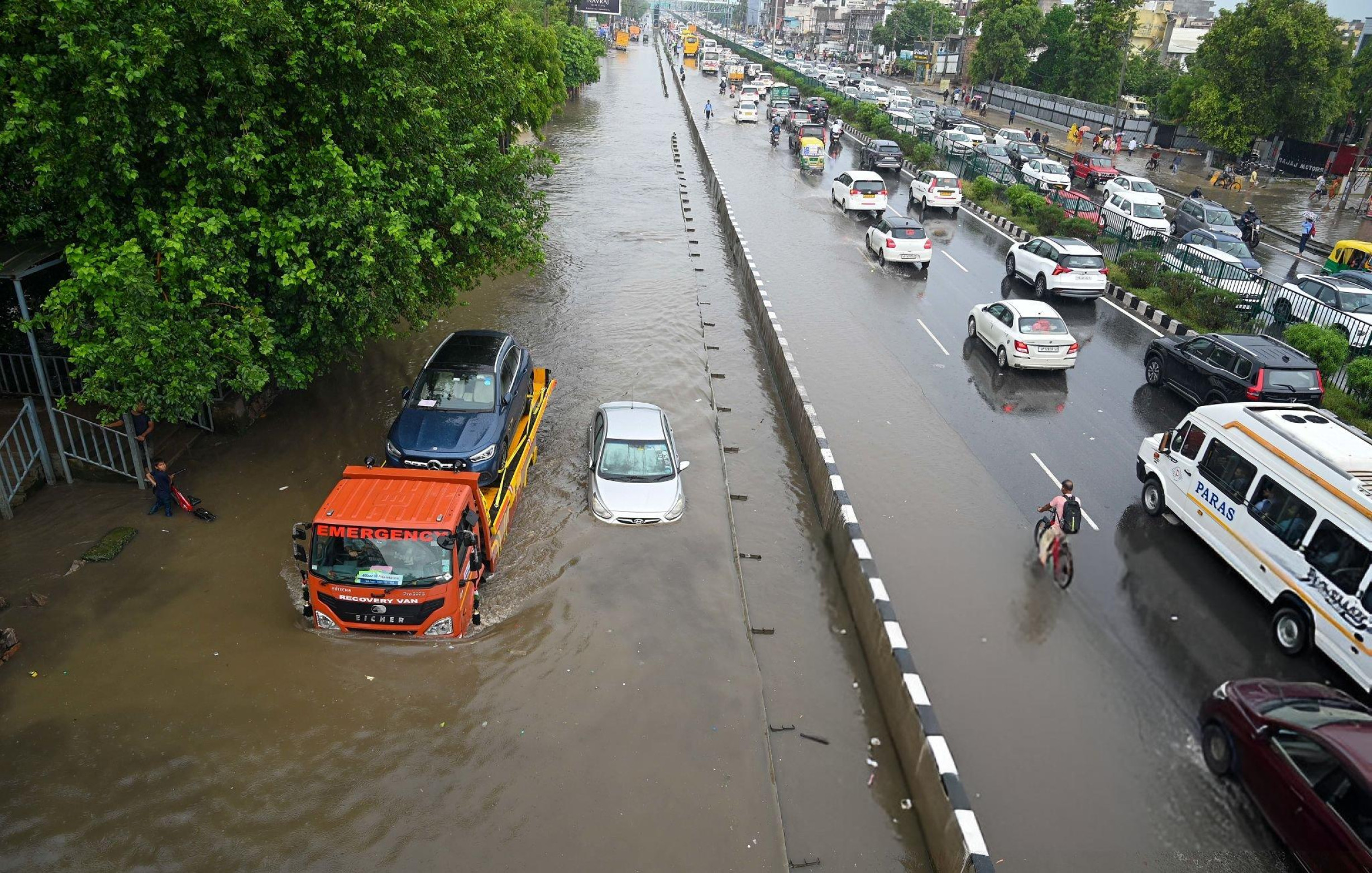It’s a terrible situation unfolding in Gurugram, India’s top city for businesses and homes. Once again, severe urban flooding has really hit the city hard. In just the last two days, non-stop rain has led to the heartbreaking loss of eight lives, major damage to buildings and roads, and a serious need for help for people living there.
A Crisis Unfolds: 48 Hours of Chaos
It all started as just a seasonal rain shower, but it rapidly turned into a full-blown city-wide crisis. Major roads like Golf Course Road, Sohna Road, and sections of
NH-48 were completely flooded. Even places often called “modern marvels,” like fancy residential complexes and corporate parks, ended up underwater, with water
reaching up to people’s waists. On top of that, the power went out and the drinking water got contaminated, making an already bad situation even worse.

People who saw what happened described truly frightening scenes: families stuck on their rooftops, cars floating away, and sewage mixing into the floodwater. It was
tough for emergency services to help because the roads were blocked and the communication lines had collapsed.
Anuj Mehta, who lives in Sector 82, shared his experience: “We called for help at 4 a.m. My elderly parents were trapped in the basement. Nobody came until noon.”
Eight Lives Lost: A Preventable Tragedy
Among the eight people who sadly lost their lives were:
- Two schoolchildren, tragically electrocuted while wading through a flooded street.
- A food delivery person who was swept away near IFFCO Chowk.
- A factory worker who became trapped in a waterlogged underpass.
All these deaths took place in areas that are known to be flood-prone and had been identified as such in previous city surveys. This has led many to question whether there was a failure in civic responsibility and accountability.
Experts Point to Urban Planning Failures
Even though Gurugram is often seen as a global city, experts have repeatedly cautioned that it’s just not built to handle severe weather conditions. The recent floods really brought home how fragile its systems are:
- Unregulated Construction: Developers have been taking over many lakes and natural drainage channels, meaning there’s nowhere for rainwater to go naturally.
- Outdated Drainage Systems: Most of the city’s pipes and drains were planned back in the 1980s and simply can’t cope with the number of people living there now, or the kind of rainfall they’re experiencing.
- Ignored Flood Mapping Reports: A report from the Haryana Urban Development Authority way back in 2022 pointed out exactly which areas were prone to flooding, but apparently, nothing was done about it.
This wasn’t a natural disaster; it was caused by human decisions,” explained Dr. Kavita Sharma, an urban policy expert at the Centre for Ecological Research. “Gurugram’s shiny image is actually resting on very shaky ground
Corporates and Citizens Alike Affected
India’s Northern tech hub, often called the ‘Silicon Valley North’, known for its offices housing major players like Google and Accenture, along with numerous Fortune 500 companies, was forced to evacuate. Many quickly switched back to remote work policies. However, it was the blue-collar workers in industrial areas near Manesar and Udyog Vihar who suffered the most, largely because they lacked insurance and had limited access to emergency help.
Government Response: Too Little, Too Late?
In response, the Haryana government has announced ₹20 crore in immediate relief funds and sent in NDRF teams to assist with rescues. Chief Minister Nayab Saini has publicly acknowledged the disaster and ordered an investigation into the drainage system failures. Despite this, public trust remains quite low.
Opposition parties and various civil society groups are now calling for:
- An independent flood audit of Gurugram’s infrastructure.
- Holding construction companies and officials criminally liable if they ignored zoning laws
- Urgent action to restore wetlands and clear stormwater drains.
The Bigger Picture: Climate Change Meets Poor Urban Governance
The flooding in Gurugram isn’t an isolated incident. We’ve seen similar situations recently in Bengaluru, Mumbai, and parts of Noida too. As climate change makes the monsoon season more unpredictable, cities all over India need to get ready for a future with more frequent and severe urban flooding.
However, experts point out that we can’t build resilience against climate change without tackling the fundamentals. We need enforceable zoning laws, investment in green infrastructure like parks and wetlands, and a complete rethinking of how accountable our city governments are.
A Wake-Up Call for Urban India
Now that Gurugram is dealing with the consequences, the main question isn’t just about rebuilding, but about building smarter this time. This disaster is a stark reminder that fancy glass buildings and luxury housing can’t hide deeper, systemic problems.
If India’s vision for its cities is going to be sustainable, it needs to be based on planning ahead, taking responsibility, and including everyone—not just chasing quick profits and attractive marketing.










